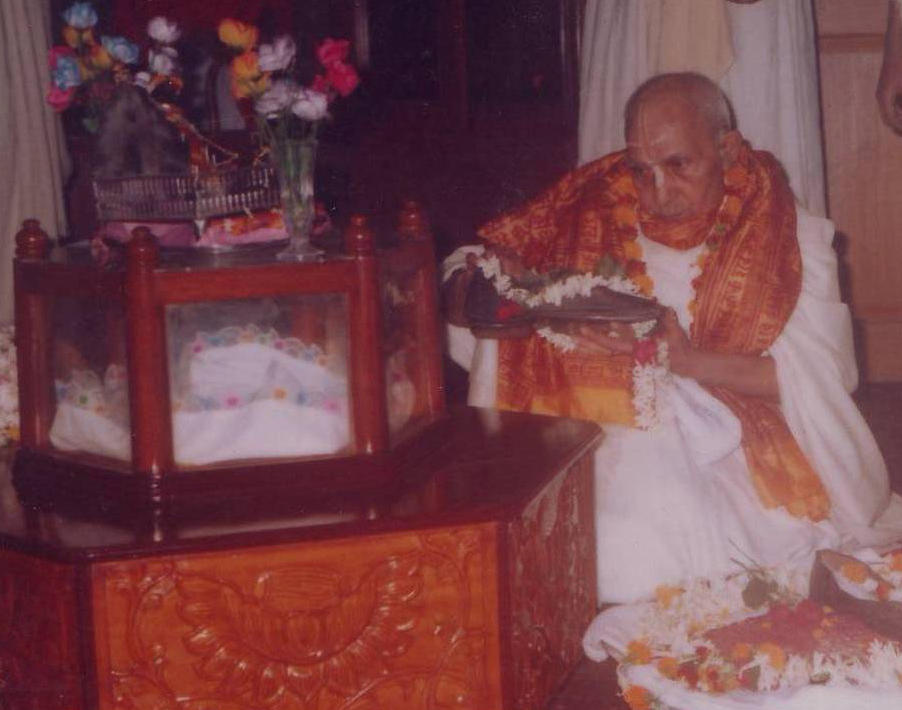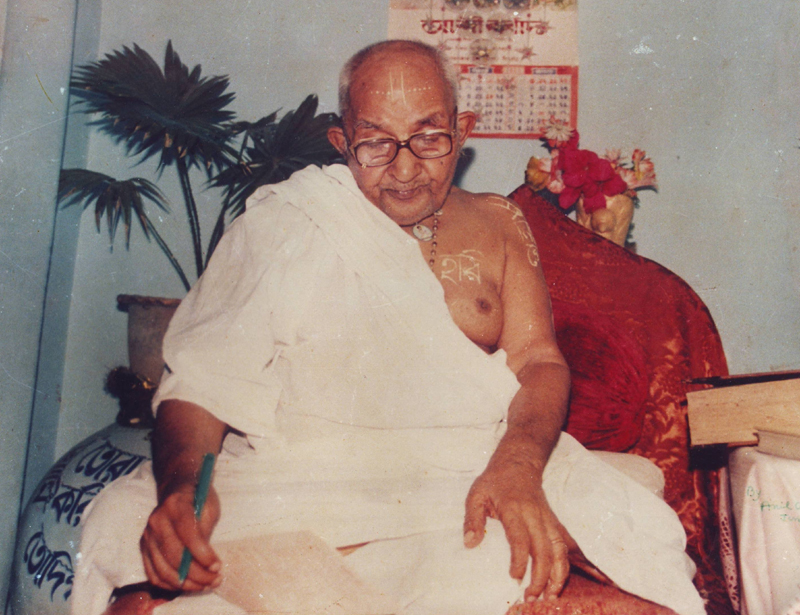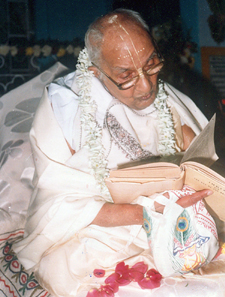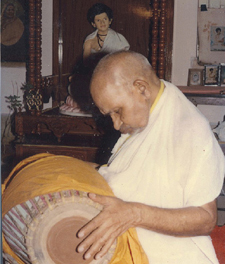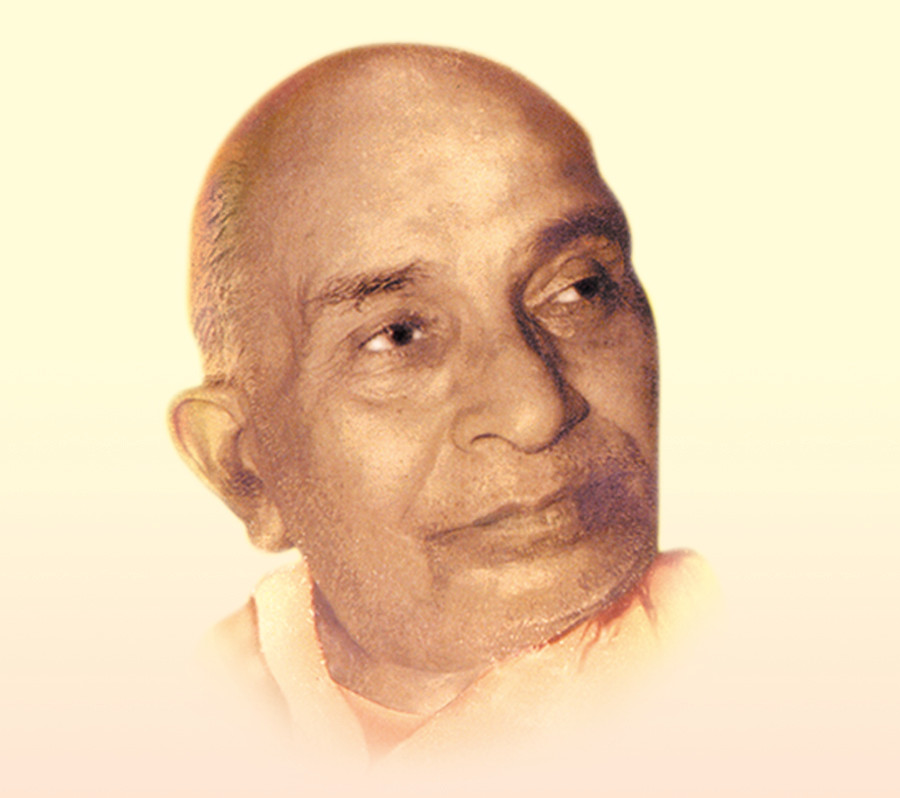
Birth & Parentage
Srimat Mahanambrata Brahmachari (Pre-ashramite name ‘Bankim’ )was born of parents, Kalidas Dasgupta and Kaminisundari Devi, in the village Khalisshakota, district Barisal, bengal, India (now Bangladesh ) on the Christmas day, 25 th December in 1904. He was the youngest of three, a sister and two brothers, belonging to classagrarian Hindu family, vaidya commnuity ----a higher caste in Hindu hierarchy. The parents were notable in the locality for nobility, scholarship and religious inclination.
Early Boyhood & Education
The learning of Bankim began in a nearby Pathshala in 1909 and continued thereafter in village English school. At that time his father lost eye-sight totally and became partially deaf. Bankim, dedicated himself to blind father’s service, had to read aloud scriptures, such as Mahabharat, Upanishad , Gita , Bhagabatam etc. For father’s eagerness and satisfaction , Bankim and his family members were patriotic in nature and extended support to the cause of Non-co-operation movement and boycott of British Goods initiated by Mahatma Gandhi and began to spin Charka and were Khaddar since then till attainment of independence in 1947.
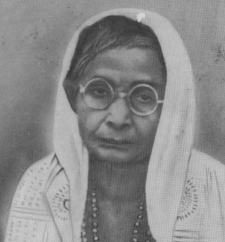
Mother Kaminisundari Devi
He also gave up English School education being inspired by the call of Desbandhu C. R. Das who stated English education as ‘Slave making machinery’. Then he pursued his studies in Sanskrit Tol for 2 years. The news of Prabhu Jagadbandhu , the new incarnation of Sri Gouranga Mahaprabhu , that Prabhu came out of his cottage at Sri Angan Faridpur town after seclusion for 16 years 8 months and giving ‘darshan’ to thousand of people gathering there everyday---was the most auspicious turning point in Bankim’s life. His heart received the news as unfailing truth and by the grace of Sripad Mahendraji , the chief Sebait of Prabhu , he was able to touch and worship the lotus feet of prabhu .After this incidence Lord Bandhusundar became the personal deity ( Ishta ) of all the worships of Bankim and Sripad Mahendraji became his mentor or Guru. After sometime in September 1921 , he got with utmost grief, the news of Prabhu Jagadbandhusundar's departure from normal self and assuming the appearance of a dead man ( Popularly known as trayodash dasha which is a sublimated condition of divine love or a very higher stage of Mahabhava).
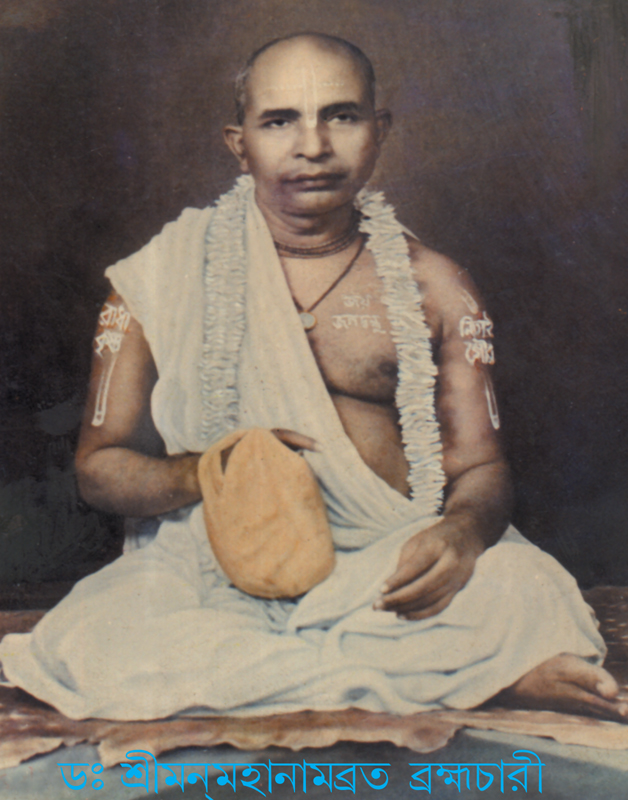
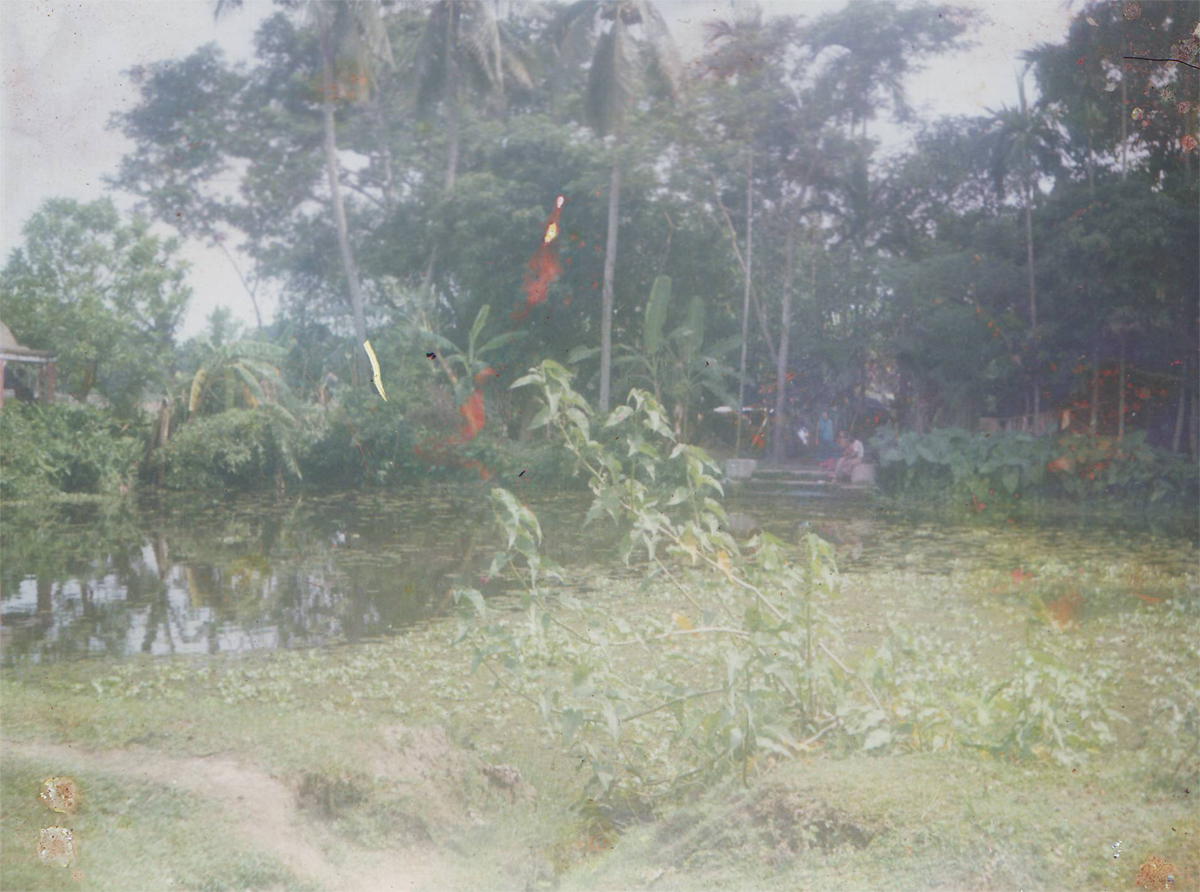

| Ascetic Life & Higher Education |
|
Bankim’s father breathed his last in 1922 . On completion of last rites and rituals for the departed soul Bankim appeared at Sri Angan , Faridpur to become an ascetic monk of MAHANAM SAMPRADAYA ,the association dedicated solely for propagation of teaching and ideals of Prabhu Jagadbandhu . But Sripad Mahendraji , the then spiritual master and founder President of Mahanam Sampradaya asked Bankim to return home , pass the Matriculation examination first and thereafter to come to become a monk . Bankim’s eagerness for ascetic life prompted him to take the first available opportunity to sit for the matriculation examination. As he was out of touch with English School education for the last two years he had to study a few subjects including English anew. In 1923 he appeared at the matriculation examination and obtained District Scholarship . He left home for good , came to Sri Angan , Faridpur and was initiated as Ashramite monk by Sripad Mahendraji with the Ashram name , Mahanambrata Brahmachari . He used to serve the Asram heart and soul. Some time later Mahendraji asked him to take admission in Rajendra College, Faridpur for further studies. After performing various duties of the Ashram and attending College-classes he had hardly any time for studies. On many an occasion he had to carry on without mid-day meals because of prevailing poverty to the Ashram and his absence during meal time for attending College classes. With such trials and tribulations he passed B.A. exam in 1928 with Honours in Sanskrit. As desired by Mahendraji , he studied M.A. in Sanskrit which he passed from Calcutta University in 1930 obtaining first class first position though appeared in sick bed . At the advice of Mahendraji he studied M.A. in Western Philosophy in Calcutta University and passed the examination honourably.During the middle of 1933 , the result of his second M.A. Exam was yet to publish , when Mahendraji as President of Mahanam Sampradaya received an invitation from the President of World Fellowship of Faiths, Chicago , U.S.A. to send delegate to attend and deliver speeches in its conferences . Mahendraji thought this was the best platform to preach the most noble and beneficial teachings, Gospel and ideals of Prabhu Jagadbandhu which would usher in an era of greatest good to the humanity. He sent Srimat Mahanambrata Brahmachari , though he never addressed any public gathering earlier. Mahanambrataji had to leave for U.S.A. without having full passage money for which he had to suffer from untold mental agony, affliction and anxieties. He ultimately reached Chicago by the sheer grace of Prabhu Jagadbandhu.
|
Participation at World Fellowship of Faiths
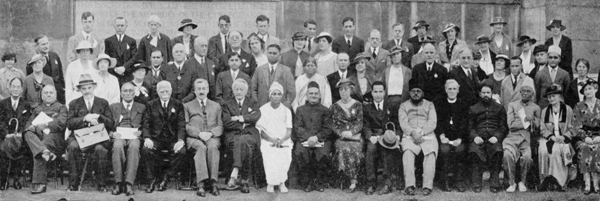
( Dr. Brahmachari at the center clad in white robe of his monasric order
Two World Religious Conferences were held in Chicago, U.S.A. – the first World Parliament of Religion in 1893 where Swami Vivekananda representing Hindu religion earned crowning victory by his towering personality and outstanding oratory; the second World Fellowship of Faith in 1933 where Srimat Mahanambrata Brahmachari representing his own Vaisnaba religious faith following the gospel and teachings of Prabhu Jagadbandhu emerged most prominent and outstanding by his deep spiritual insight, firm conviction and most notably informing and inspiring oratory. In World Fellowship of Faiths there was no rivalry of religions for supremacy, but in the words of Chief Executive Charles F. Weller – “For the first time in history, people of All Faiths, Races and Countries are drawing together – seeking spiritual solution for man’s present problems – such as War, Prosecution, Prejudice, Poverty amidst Plenty, antagonistic Nationalism, Ignorance, Hatred, Fear.” That is, each Faith was to speak of its own solution to those world problems. The total number of delegates was 199 and that of addresses 242.
| Achievements at World Fellowship of Faiths and USA |
|
Srimat Mahanambrataji was permitted to deliver four lectures in the main conference and that gained high appreciation and exerted profound influence on a number of eminent persons of Chicago and organisers of World Fellowship Convention. His stay in America was prolonged at their insistence and endeavour, changing his Traveler’s visa to Student visa. He had to take admission in Chicago University for Ph.D. degree which he obtained in 1937 for outstanding research work on Goudia Vaisnaba Philosophy or the philosophy of Sri Jeev Goswami. He was the first scholar to analyze and establish Gouriya Vaisnab Philosophy as a standard system of philosophy amongst the western philosophersthrough his thesis work later printed as a book named Vaisnav Vedanta. He had the unique distinction of becoming International Secretary of the World Fellowship Organisation. He was actively engaged with the various follow-up activities of World Fellowship movement. He was sent to London, England to take part and deliver lecture in the 2nd International Congress arranged by World Fellowship of Faiths in 1936.
|
|
In this event in 1936, he delivered a number of commendable speeches and met his teacher and noted Indian Philosopher Dr. Sarvapalli Radhakrishnan and became very friendly. He visited several European countries on goodwill lecture tour. He made notable contributions to various magazines – both Indian and American. In1938 he as the Secretary of the Intercultural Committee of the International Fellowship movement visited 63 leading American cities on goodwill lecture tour and delivered 354 addresses. He was the guest lecturer in 29 Universities and Colleges of America and lectured in scores in High Schools, Social and civic club. He was invited to visit and deliver lectures at several places in Canada before his departure for India in February, 1939. He used to wear always clothes made of home-spun Khaddar and speak without note in his addresses. While he was a student in Chicago University, one of the teachers requested him to part with his unusual clothes and wear civil dress like others, lest he would be an object of criticism. He replied that he could not part with that dress for a moment, as this was the Indian protest against British imperialism. Thereafter a notice was given in University Board and University magazine ‘Maroon’ warning students against criticising him for dress. He thought that his dress would command respect as being used by Mahatma Gandhi was held in great esteem by western people.
|
| Notable Activities after returning to India |
|
After his return from U.S.A. in April, 1939 he was requested to accept the post of Principal of a college in Barisal by Mr. Fazlul Haque, the then Prime Minister of Undivided Bengal, but refused politely and preferred to continue his monastic life and lecture tours to arouse moral and spiritual consciousness of people of India, particularly of undivided Bengal. He dedicated his whole life in propagating the message of ‘Srimadbhagabat’ in Bangladesh and all over Eastern India. Since partition of the country and formation of India and Pakistan in 1947, he preferred to remain as an East Pakistan national in order to safeguard and protect the civilisation, religion and culture of minority Hindus. When all other religious institutions left East Pakistan due to inhuman torture, murder, loot, arson including destruction of temples, deities of Maths, Dr. Brahmachariji with all risks of life widely toured from one corner of Bangladesh to another and extended moral support and inspiration to religious minority people. It was only he who stood by the side of lakhs of devastated and ruined Hindus of the-then East Bengal after the conflicts of 1949 and 1971. Like a coeternal figure he consoled and encouraged them to stay put in their country and cling to their own religion. During Bangladesh freedom struggle in 1970-71, thousands of people were killed including 8 (eight) monks of Sri Angan, Faridpur. Pak soldiers destroyed many famous temples. Dr. Brahmachariji gave up taking rice with a vow that he would not take it again till the liberation of Bangladesh (then East Pakistan). He personally visited the affected areas, temples, and relief camps where thousand of people took shelter giving them psychological support as well as material assistance. He set up “ Devasthali Samskar Samity” and appealed to generous people and religious institutions of India to raise funds for reconstruction of temples and reinstallation of deities and was personally present during reinstallation at many places. In 1975 he founded the “Bangladesh Sanatan Dharma Mahamandal” to look after the religious and cultural interests and heritages of Hindus, being its President, The great assembly of the Mahamandal was held at Narayangunj in 1976 where people from different districts and remote places of Bangladesh participated.
|
| Cultural & Literary Contribution |
|
His most notable and outstanding contributions were his exquisite exposition on Hindu scriptures and writings – such as Gita Dhyana, Upanisad Bhavana, Chandi Chinta, Srimad Bhagabatam 10th Skandha, Gour Katha, Uddhav Sandesh, Vaisnava Vedanta, books on the life and Teachings of Sri Gouranga Mahaprabhu and Prabhu Jagadbandhu and many other works. He was an extraordinary exponent of Religion of Man. His last works were expositions in lucid Bengali of Vysadeva’s “ Brahma Sutra” and “Rig Veda”. These great books of spiritual liberation, showered peace on to many poor souls, irrespective of their religious beliefs. In 1954, honorary degree of Doctorate of Literature (D Lit) was conferred upon him the from the Vaishnav theological University at Vrindavan. In 1998, he was honored by the Sitaramdas Omkarnath Sanskrit Educational Trust and Tirupathi Sanskrit Vidyapeeth (university), by awarding to him, Mahamahopadhya title which is the highest title for scholars on the sanskrit scriptures. In this year of 1998 only, he was accorded the title of ‘Bharat- Shiromoni’, in a civic reception that was organised by ‘Kolkata Nagarik Samiti’ at south Calcutta’s Nazrul Manch; in the august presence of Hon. Governor of West Bengal Dr. A.R. Kidwai and ex- chief justice of supreme court, Justice Sri Ranganath Mishra, 4-5 vice chancellors, sheriff of Kolkata, ministers and eminent persons of Kolkata. He had to his credit the erection of math and temple in Nabadwip, Puri, Vrindavan, Ghurni (Krishnanagar) in India and at several places in Bangladesh. He was an erudite scholar and vaisnava saint and store-house of scriptural knowledge and acted as spiritual-guide to not only a large number of people and but also to heads of religious institutions. Mahanambrataji was also a profound philosopher, poet, literary personality, devotional song writer, organiser and above all a humanitarian. He was not only a personality but was an institution itself. Underneath all these diversified qualities of his, there was a core philosophy which linked all his activities and that was ‘Manab Dharma’ which means every human being will aim to attain humanity and help others to attain the same. He was the main spokesman of ‘Manab Dharma’. His uniqueness was the all embracing understanding of Sanatan (Hindu) Dharma as Manab Dharma and nothing but Manab Dharma. The mission of his life, as understood from most of his activities, was to awaken ‘Manusyatta’ or humanity in all people irrespective of caste, creed, country and religion. He passed away on 18th October, 1999 (Mhanabami tithi) at an age of 95 years. At old age infirmity had its grip on his body but could not affect his mind, which was as alert and active as that of a young person. So noble, so intellectual, so religiously inclined, so unassuming, so charming, so ego less as he was, can hardly be found. He is still and will be among us. Through his outstanding works which will be appreciated over time immemorial, at the heart of large number of people to whom he acted as spiritual guide and in the memory of numerous admirers who loved him without being connected to him spiritually or religiously, he shall live for ever.
|
| APPRECIATIONS IN U.S.A. |
|
1. Prof. Carl F. Propson of Chicago University wrote (Oct. 12, 1933) to Sripad Mahendraji Hearing the first lecture of Srimat Mahanambrata Brahmachari:- “We desire to thank you for having made it possible to be our guest, Sreemat Mahanambrata Brahmachari, whose enlightenment and knowledge, together with his simple and unassuming manner has endeared him to all with whom he has come info contact since arrival in Chicago”
2. Prof. Charles W. Gilkey, University of Chicago wrote (Dec. 21, 1937):-“Partly through the picturousqueness of his monastic costume, and far more through the winsomeness of his personality, the keenness of his mind, the catholicity of his point of view, and not least his deeply religious spirit, he has commended himself to our confidence and affection in an unusual degree.” 3. Charles F. Weller wrote (June 25, 1938) to Srimat Mahanambrata Brahmachari :- “I congratulate and thank you for the notably-successful, six months lecture tour, under our auspices, which you recently made, from Chicago to the Pacific, north into Canada, and east to New England, Having personally heard a number of your addresses (in Chicago, London, Los Angeles, Santa Barbara, San Francisco, New York, Massachusetts etc.) and having received enthusiastic reports from many of your auditors, I can say, with authority, that you have instructed and inspired a very large number of people by your able and convincing interpretations of India’s contributions to the world and by the rare tact, kindliness, modesty, wit, and profoundly spiritual discernment which you have manifested. Since 1924, my chief colleague has been a Hindu and I have met and heard, with deeply fraternal appreciation, many eminent men and women from India. But, you have given me a larger, truer understanding of India’s Caste System, Educational Methods, Family Life, Religions, Political Situation, Purposes and leadership, Philosophies, Experiences, and Creative Ideals that I have had.I believe you are clearly called (and splendidly prepared) to render in many countries, a nobly-great, urgently-needed services to humanity”. 4. Mr. Gertrude H. Williams, General Secy. World Fellowship announced (July 4, 1938):- “He (Mahanambrata) came to Chicago in 1933, to take part in the First World Fellowship of Faiths. Since then, he has worked as an International world Fellowship Secretary. He is a venerable personality marked by simplicity and great sincerity. He is “Nobly spiritual, truly scholarly, unselfishly devoted to human service-sane, competent, witty and eloquent in depicting India’s conditions and contributions”. His tour in different part of the United States as the Intercultural Secretary of the International Fellowship Movement is bound to be of great significance in the promotion of better intercultural cooperation and understanding.” 5. Prof. Charles W. Morris wrote (Dec, 6, 1983):- “It was my good fortune to have Dr. Mahanambrata Brahmachari as a student at the University of Chicago for a number of years, and as his adviser, I came into close contact with him as a person. Dr. Brahmachari possesses the personal and cultural equipment for significant interpenetration of the philosophical and cultural activities of the East and West. In his work for the Doctorate, which the University conferred upon him, he showed his effectiveness as a scholar; before University classes and public audiences he was shown that he is an effective teacher and speaker. I hope very much that he will find himself in a position in which he can make effective use of his abilities and resources. I may add that I do not speak for myself alone in these matters. All of the members of Department who worked with Dr. Brahmachari formed a high opinion of his work and person, and we all wish him well in entering upon new spheres of activity” 6. Charles F. Weller, Chief Executive of World Fellowship wrote (Feb 3, 1939) to Sri Angan, Faridpur:- “You will be glad, I believe, to have me personally tell you about a remarkable young Hindu who has brought to 63 American cities the visited, noblest interpretations I have ever heard of India’s customs, conditions, aspirations and achievements. Personally hearing a number of these address, I was moved to fraternal enthusiasm by his rare combination of wisdom and wit, with quiet, modest self-assurance, large human friendliness and notably informing and inspiring oratory. He also went with us (and lived with me) in London, England, where he spoke wisely and well at many session of our Second International Assembly, the World Congress of Faiths. I believe he will make nobly-outstanding contributions, in many lands, to an effective human consciousness of the world-wide, diversified, fraternal Oneness of All Life.” |
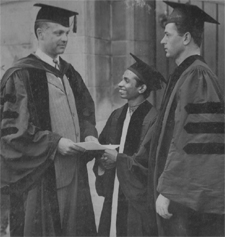
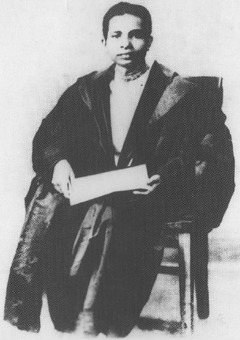
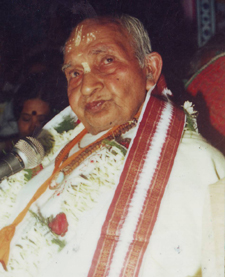
Dr. Mahanambrata Brahmachari during one of his famous spiritual discourses
